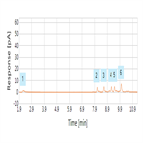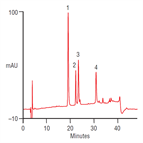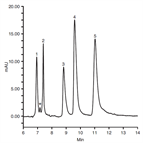Find methods for your needs
Refine by Feature
Displaying 1-5 of 6 results for Tag: Insulin
A Fast and Accurate Method to Monitor Protein PEGylation Reactions by HPLC-UV-CAD
Instrument Type: HPLC-CADThis application provides a fast and accurate way for biopharmaceutical chemists to monitor PEGylation reactions by using HPLC with complementary UV/Vis and charged aerosol detection. A high resolution separation on the MAbPac RP resolves PEGylation reagents, unreacted insulin, and PEGylated insulin products that differ in the number and sites of attached PEG.
Selecting buffers to remove uncertainty in tryptic digestion
Instrument Type: HPLCThe Thermo Scientific SMART Digest kit was used for the digestion of insulin. A variety of common buffer additives were compared to the SMART Digest buffer. Samples were analyzed on a Thermo Scientific Dionex UltiMate 3000 RSLC system via reversed-phase separation on a Thermo Scientific Accucore C18 column, with UV detection at 280 nm.
Simple gradient method for the analysis of protein standards by micro LC
Instrument Type: HPLCThe Thermo Scientific HPLC system is applied for the analysis of protein standards. The separation is performed on a Thermo Scientific Acclaim 300 C18 micro LC column, with UV detection at 214 nm.
Rapid separation of high and low molecular weight peptides using a solid core C18 HPLC column
Instrument Type: HPLCThe separation of peptides was successfully achieved on the Thermo Scientific Accucore C18 HPLC column. Basline resolution was achieved between high and low molecular weight peptides with a simple gradient method with a run time of 10 minutes
Improved analysis of intact proteins using a Thermo Scientific Accucore 150-C4 150 Å pore diameter nanoLC column
Instrument Type: HPLCThe Thermo Scientific HPLC system is applied for the analysis of intact proteins (*indicates an impurity from carbonic anhydrase). The separation is performed on a Thermo Scientific Accucore 150-C4 150 Å pore diameter nanoLC column, with UV detection at 214 nm. The 150 Å pore size enables the effective analysis of molecules unable to penetrate into smaller diameter pores, whilst the low hydrophobicity C4 phase results in protein separation by hydrophobicity.





